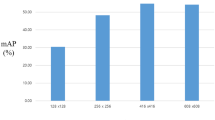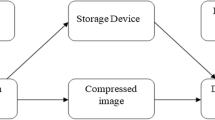Abstract
In this paper, we address the design of data processing and error control strategies for a wireless sensor network for video-surveillance applications, so as to optimize its performance in terms of energy consumption, information delivery delay, and information quality. First, we suggest a video coding strategy based on intelligent distributed processing, which yields very low power consumption. Then, we investigate the interactions between energy consumption, quality, and delay, and analyze the system performance when ARQ- and FEC-based error-control techniques are applied. As a result, we propose an optimal configuration for wireless video-surveillance networks which adapts to the radio channel state by effectively implementing FEC and ARQ techniques.
Similar content being viewed by others
References
R.E. Badra and B. Daneshrad, Adaptive link layer strategies for asymmetric high-speed wireless communications, IEEE Transactions on Wireless Communications 1(3) (2002) 429–438.
D. Bertsekas and R. Gallager, Data Networks (Prentice-Hall, Englewood Cliffs, NJ, 1992).
R.T. Collins, A.J. Lipton, H. Fujiyoshi and T. Kanade, Algorithms for cooperative multisensor surveillance, Proceedings of the IEEE 89(10) (2001) 1456–1477.
J.L. da Silva Jr., J. Schamberger, M.J. Ammer, C. Guo, S. Li, R. Shah, T. Tuan, M. Sheets, J.M. Rabaey, B. Nikolic, A. Sangiovanni-Vincentelli and P. Wright, Design methodology for picoradio networks, in: Proc. of DATE 2001, 2001.
D. Estrin, L. Girod, G.J. Pottie and M. Srivastava, Instrumenting the world with wireless sensor networks, in: Proc. of ICASSP 2001–IEEE Internat. Conf. on Acoustics, Speech, and Signal Processing, 2001.
W.R. Heinzelman, A. Chandrakasan and H. Balakrishnan, Energy-efficient communication protocol for wireless microsensor networks, in: Proc. of Hawaiian Internat. Conf. on System Science, January 2000.
Joint Video Team (JVT) of ISO/IEC MPEG and ITU-T VCEG, Document JVT-C167, Joint Committee Draft (CD) (May 2002).
T.-W.A. Lee, S.-H.G. Chan, Z. Qian, Z. Wen-Wu and Z. Ya-Qin, Allocation of layer bandwidths and FECs for video multicast over wired and wireless networks, IEEE Transactions on Circuits and Systems for Video Technology 12(12) (2002) 1059–1070.
A. Majumda, D.G. Sachs, I.V. Kozintsev, K. Ramchandran and M.M. Yeung, Multicast and unicast real-time video streaming over wireless LANs, IEEE Transactions on Circuits and Systems for Video Technology 12(6) (2002) 524–534.
M. Martina, A. Molino and F. Vacca, Reconfigurable and low power 2D-DCT IP for ubiquitous multimedia streaming, in: ICME 2002–IEEE Internat. Conf. on Multimedia and Expo, Lausanne, Switzerland, 2002.
P.K. McKinley, T. Chiping and A.P. Mani, A study of adaptive forward error correction for wireless collaborative computing, IEEE Transactions on Parallel and Distributed Systems 13(9) (2002) 936–947.
S.S. Pradhan, J. Kusuma and K. Ramchandran, Distributed compression in a dense microsensor network, IEEE Signal Processing Magazine (March 2002) 51–60.
J.G. Proakis, Digital Communications (McGraw-Hill, Boston, 2001).
J.A. Saghri, A.G. Tescher and J.T. Reagan, Practical transform coding of multispectral imagery, IEEE Signal Processing Magazine (January 1995) 32–43.
E. Shih, B.H. Calhoun, S.-H. Cho and A.P. Chandrakasan, Energy-efficient link layer for wireless microsensor networks, in: Proc. IEEE Computer Society VLSI Workshop, May 2001.
A. Sinha and A.P. Chandrakasan, JouleTrack–A Web based tool for software energy profiling, in: Proc. of Design Automation Conference, 2001, pp. 220–225.
D. Slepian and J.K. Wolf, Noiseless coding of correlated information sources, IEEE Transactions on Information Theory 19(July 1973) 471–480.
K. Sohrabi, J. Gao, V. Ailawadhi and G.J. Pottie, Protocols for self-organization of a wireless sensor network, IEEE Personal Communications 7(5) (2000) 16–27.
C. Sunhyun and K.G. Shin, A class of adaptive hybrid ARQ schemes for wireless links, IEEE Transactions on Vehicular Technology 50(3) (2001) 777–790.
M. Zorzi and R.R. Rao, Error control and energy consumption in communications for nomadic computing, Special Issue on Mobile Computing of IEEE Transactions on Computers 46 (March 1997) 279–289.
M. Zorzi, R.R. Rao and L.B. Milstein, ARQ error control for fading mobile radio channels, IEEE Transactions on Vehicular Technology 46(2) (1997) 445–455.
Author information
Authors and Affiliations
Rights and permissions
About this article
Cite this article
Chiasserini, CF., Magli, E. Energy-Efficient Coding and Error Control for Wireless Video-Surveillance Networks. Telecommunication Systems 26, 369–387 (2004). https://doi.org/10.1023/B:TELS.0000029047.09283.d2
Issue Date:
DOI: https://doi.org/10.1023/B:TELS.0000029047.09283.d2




